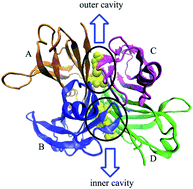Probing the binding mechanism of polybrominated diphenyl ethers with transthyretin by multi-spectroscopic and molecular dynamics simulations
Abstract
The physical and chemical properties of polybrominated diphenyl ethers (PBDEs) are important for modeling their transport. The primary objective of this study was to evaluate the interaction of transthyretin (TTR) with BDE-100, 3-OH-BDE-100 and 3-MeO-BDE-100 using fluorescence spectroscopy, three-dimensional fluorescence, circular dichroism (CD), molecular docking and molecular dynamics methods. These PBDEs significantly quench the intrinsic fluorescence of TTR via static mode and non-radiation energy transfer. Then, the secondary structure and kinetic parameters of the protein were analyzed by three-dimension fluorescence spectra, CD spectra and molecular dynamics simulations. The results suggest that the binding of BDE-100, 3-OH-BDE-100 and 3-MeO-BDE-100 to TTR can induce conformational changes. According to molecular docking and thermodynamic method, hydrogen and van der Waals force driven BDE-100 binding with TTR and hydrophobic attractions may be the key factors for the stability of the TTR-3-OH-BDE-100 and TTR-3-MeO-BDE-100 complex. Moreover, docking studies and free energy calculations demonstrated that Lys15, Leu110 and Thr119 are crucial and important for the binding of TTR with BDE-100, 3-OH-BDE-100, 3-MeO-BDE-100.



 Please wait while we load your content...
Please wait while we load your content...